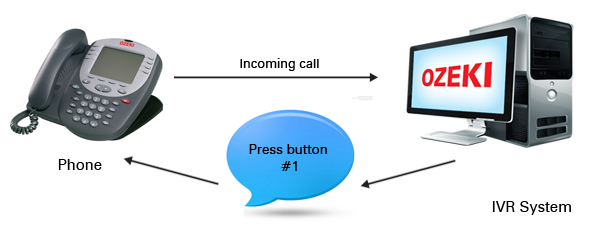Navigation in the IVR tree using DTMF commands
Ozeki VoIP SIP SDK is a remarkable help in developing your IVR solution. It also greatly accelerates development when it comes to DTMF navigation in IVR tree structure.

What is a DTMF Signal? When is it needed?
The Interactive Voice Response (IVR) systems are programs that simply play audio streams into the call after answering it and navigate the caller customer in a so-called IVR tree structure until the customer gets to the answer they seek or the tree gets to a dead end. The customer can navigate in the IVR tree using different methods but the simplest way is DTMF (Dual-tone multi-frequency) signals. DTMF signals are sent to a telephoning client when the remote user presses a button on the telephone or softphone keypad. Every keypad button on a telephone has a special frequency signal that is transferred into the call when the person presses the button.
These signals that can be recognized in the VoIP client and if there is an implemented function for the use of these sounds, the VoIP client can use them for any purpose. The signal of the given buttons is standard, so it can be perfectly used for getting information from the other end. When you want to build a DTMF navigation IVR system, you will need to capture audio files like: "If you want to get information about our newest products, please press 9." When a customer presses 9, the IVR tree will recognize the DTMF signal of 9 and navigates to the proper tree branch. The whole concept is based on this simple idea.
The navigation usually made by the IVR server playing an audio that instructs the user to press certain keypad buttons in order to get to the answer for their problem. When the user pressed the right button, the IVR system enters the appropriate branch of the menu tree and the instruction process continues. This process continues until the user reaches the bottom of the menu tree or presses a button for getting into connection with a human operator if possible.
Who can enjoy the benefits of DTMF IVR System?
DTMF IVR system is recommended mainly for companies or organizations who have to handle even thousands of telephone calls per a day. This solution makes your communication system more simple but more professional. After adopting an DTMF IVR system it is not necessary to employ a great number of employees to receive and handle phone calls. All of this staff can be handled by the IVR system by now. In this way you do not need to pay extra money for employing extra employees to your call center. And your customers will also be satisfied because you will be available all the time.
Nowadays availability via telephone is essential for corporations. Though dealing with incoming calls and document these calls can be a quite resource demanding task. Even if you have the necessary human-resource for handling calls, every call cannot be answered (the line is engaged and 24/7 availability is also source demanding). These inconvenient cases will make most of customers impatient, disappointed and dissatisfied. To avoid these cases you only need to introduce DTMF IVR functionality in your telephone system. Learn how to use the C# SIP softphone source implementation of Ozeki VoIP SDK for DTMF IVR...
Threats of a telephone system without IVR:
- It is necessary to employ lots of customer service assistants
- Customer service assistants usually forward only recorded data to customers
- Customer service assistants are overloaded if they do not only provide recorded data but need to search for data
- Numbers of simultaneous incoming calls are changeable. That is why the call center can be overloaded in other words they can not deal with all of incoming calls; or the call center has no task there are just a few incoming calls simultaneously
- Customer service is (usually) not available at 24 hours per a day. It means significant problem mainly for international companies
- Making documentation can be a significant extra work; standardization of documentation is also complicated.
- If calls are not recorded, they cannot be traced back later for overview or clarification
Ozeki VoIP SIP SDK provides all the support for implementing an IVR system that can be navigated by DTMF signals. You only need to use the provided classes and methods and you will soon have your own IVR server.
Training guides, simple examples
If you would like to visit the detailed developer documentations, you can learn much more from the Ozeki VoIP SIP SDK Training: IVR using XML lecture.
